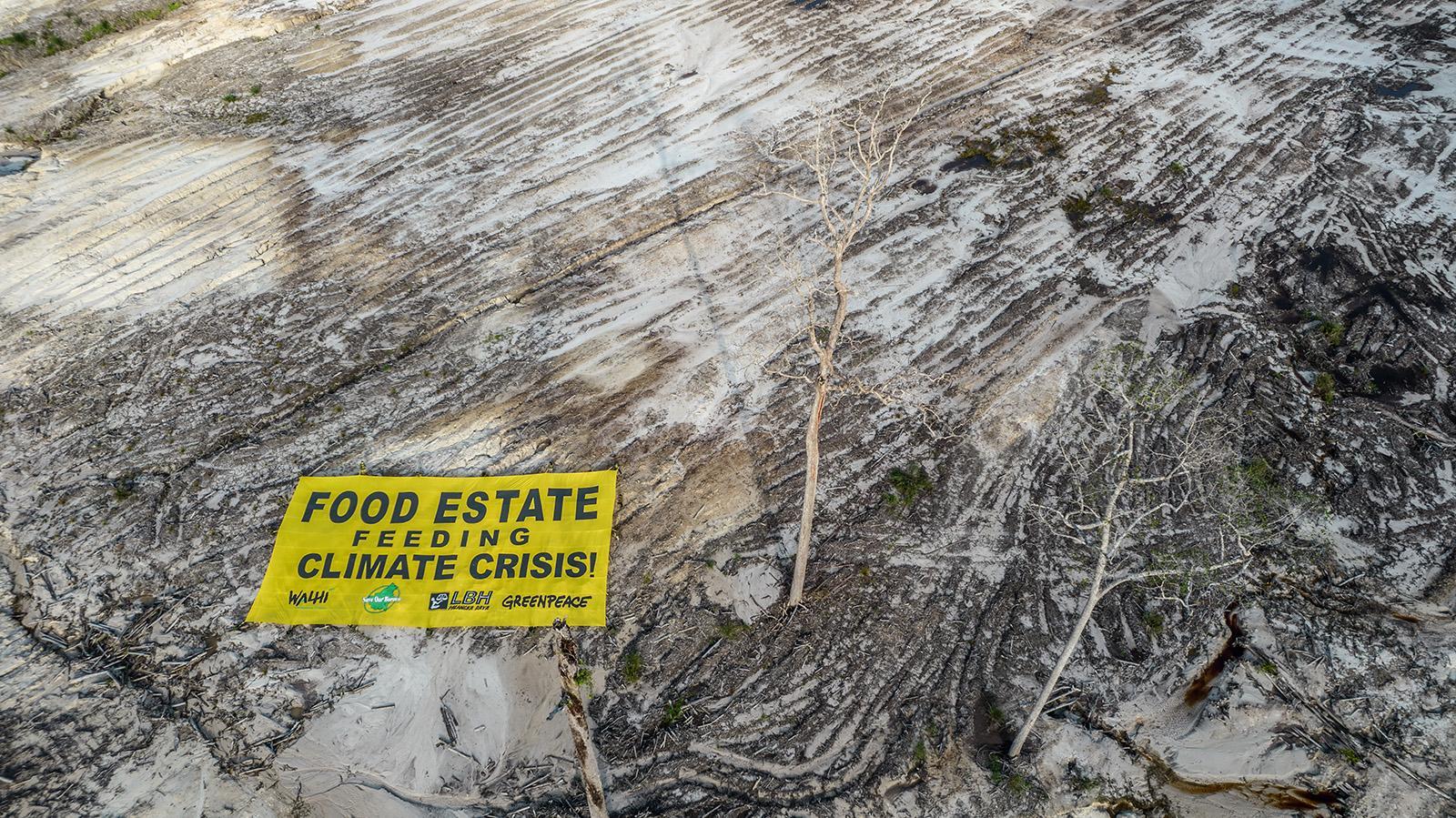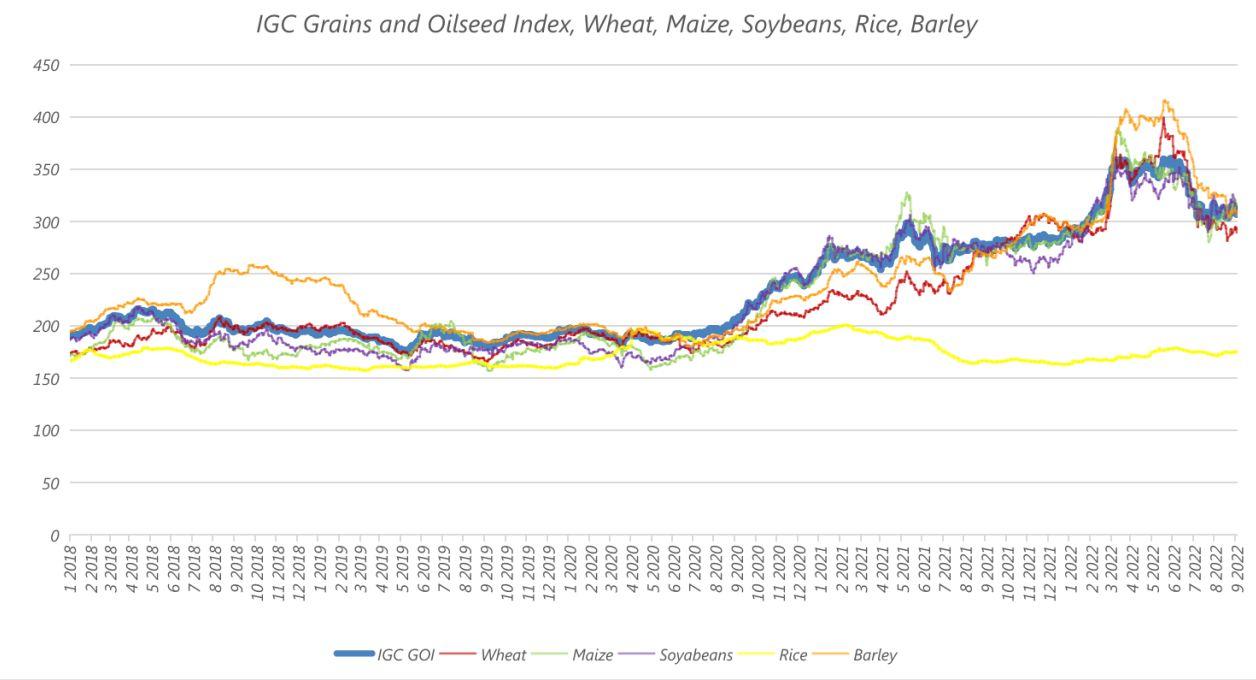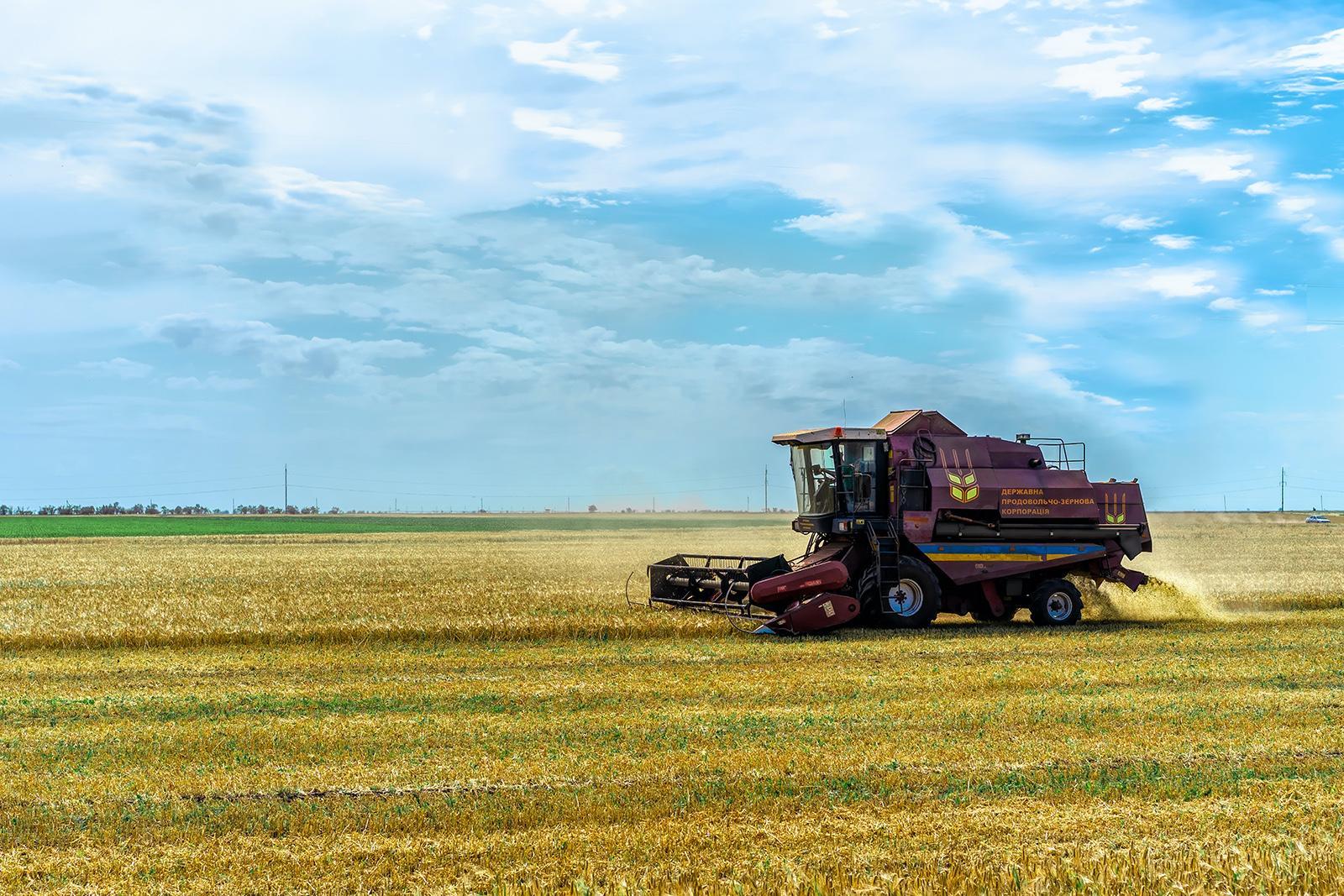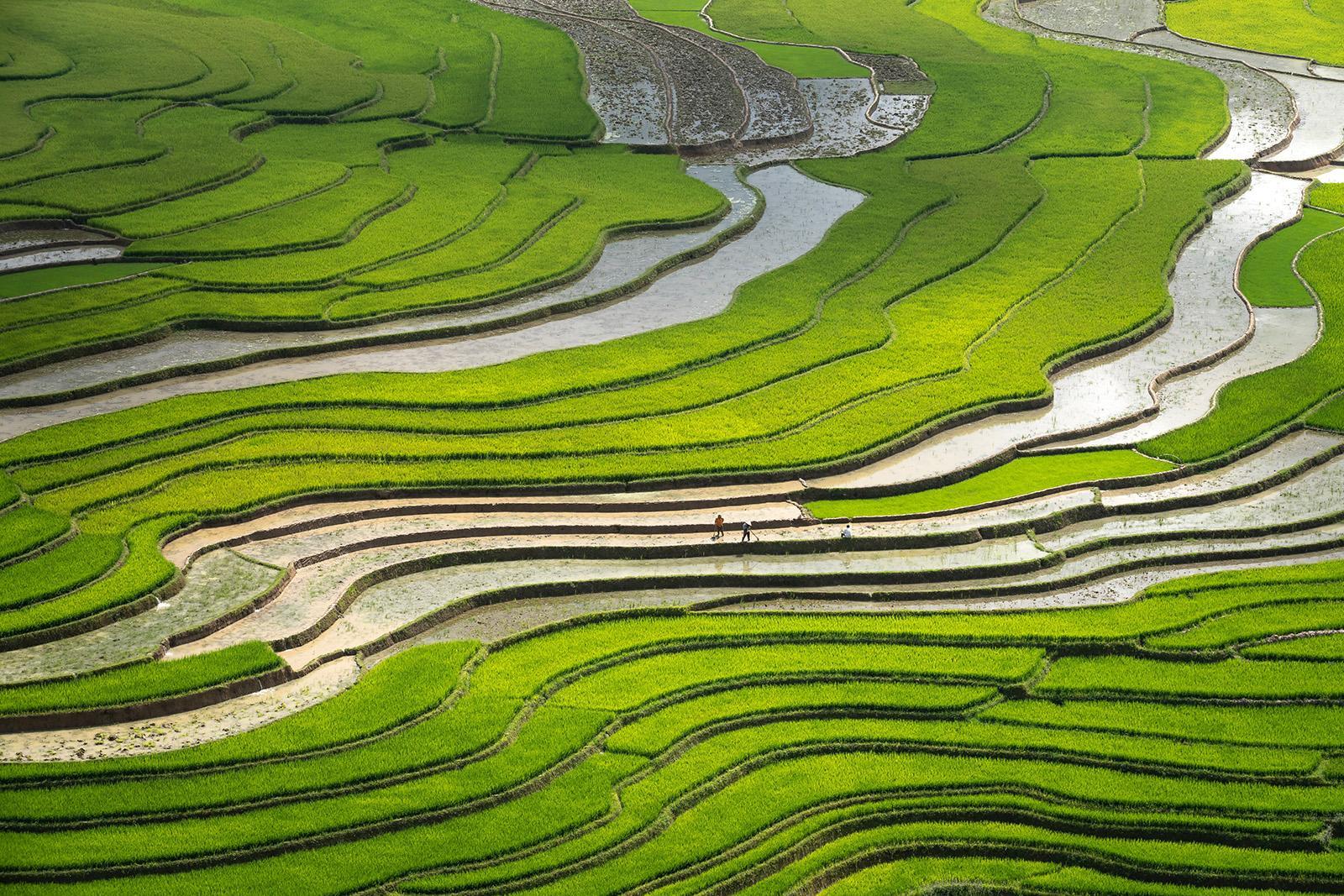Unchecked, unregulated and unaccountable: Who are the hunger profiteers?




 © Greenpeace / Daniel Beltrá
© Greenpeace / Daniel Beltrá
Abstract


This Greenpeace International report delivers a broad picture of how 20 agribusinesscorporationsacrosstheglobe– thelargestingrain,fertilisers, meat and dairy sectors – use their power to deliver outrageous profits to their shareholders while millions starve. The system must be changed to achieve the UNʼs Sustainable Development Goal of “Zero Hunger.” This reportgoesontoreassertGreenpeaceʼsvision–sharedbyLaViaCampesina and other NGOs – of food sovereignty, and calls for “an international trade order based on cooperation and human rights instead of competition and coercion,”1aswellasboldandtransformativepolicyprogress,empowering small-scalefarmersandreininginmultinationalcompanies.




“I don’t think malnutrition is a clinical condition, I think it’s a political outcome.”
Food Injustice 2020-2022 / Abstract
Scholar-activist Busiso Moyo, University of the Western Cape
© Lucas Wahl / Greenpeace
© Fred Dott / Greenpeace
© Greenpeace / Simona Cocozza
4 8
Table of Contents
Introduction: A vulnerable system
Section 1
1a

The COVID-19 pandemic
1b Russian invasion of Ukraine
14
Section 2: Mass transfer of wealth
2a Market concentration

2b Cash dividends and shareholder buyback programmes
16 18
Section 3: Remedies and recommendations
Endnotes


Food Injustice 2020-2022 / Table of Contents
© Max Zielinski / Greenpeace
Introduction: A vulnerable system
Introduction: A vulnerable system









4
Figure1:The17SustainableDevelopmentGoals adoptedbyallUNmemberstatesin2015.5
Citing past progress in reducing the global rate of food insecurity, the UNʼs Food and Agriculture Organization (FAO) was initially optimistic that the goal of achieving zero hunger by 2030 was achievable. Nonetheless, many consumersremainstructurallyvulnerable.InKenya,foodimportsrocketed bymorethan650percentbetween2008and20227whileSenegalremained heavilydependentonriceimportsdespitegrowingitsdomesticproduction.8 Since2015,theglobalrateofhungerhasonceagainclimbed(seefig.2)The UN estimates that in 2020, “between 720 million and 811 million persons worldwide were suffering from hunger, roughly 161 million more than in 2019.”9InSouthAfrica,forexample,in2021theproportionofthepopulation atriskofhungerremainedatjustbelow¼.10



Introduction: A vulnerable system




5
Figure2:Changeinrateofundernourishedpeopleworldwide.6
“Cargill sells seed and chemicals to farmers, buys their grain, transports it to Cargill feedlots, kills the cattle and sells the beef. They’re not part of the food chain; they are the chain.”
Dan Basse, president
of Chicago-based research firmAgResource
Co.
© Nick Cobbing / Greenpeace
© Greenpeace / Daniel Beltrá
For this report, Greenpeace International commissioned a research analysing 20 agribusiness corporations across the globe, the largest in each of four sectors. All research was based on publicly available data. Table 1 shows the companies analysed, within each sector, their revenue for the trailing twelve months (TTM) leading up to the outset of this research, and thecountrytheyareheadquarteredin.

Theresearchsetoutinthisreportshowsasystemicfailureofpublicpolicy, which has allowed a select group of multinational corporations to record huge profits, enriching the individuals that own them and transferring wealth to shareholders, of which the majority are located in the Global North. This demonstrates the broad direction of wealth transfer in the current food system, from producers and growers largely in the Global South,tocountriesandindividualsthatarealreadybetteroff.
This report is a warning and a call to action. A warning, because the COVID-19 pandemic and Russiaʼs war in Ukraine will not be the last major crises the world will need to weather in the 21st century. A call to action because future crises should not result in the hunger and immiseration of millions.
Greenpeace International supports a shift to a model of ʻfood sovereigntyʼ over attempts to increase food security. We hold that food security is a fundamentally flawed concept, as even increasing the number of people worldwide with “secure” access to food does not solve the problem at the heartofthecrisis:thatpeopleneedcontroloverthesystemsandresources thatfeedthem.
Ourvisionoffoodsovereigntyisbasedonasystemofsustainable,ecological farming that “supports a world where producers and consumers, not corporations,controlthefoodchain,”focusingonthewayfoodisproduced, andbywhom.11
Table1:20companiescomprisingGreenpeaceInternationalresearchfocus. TTM:trailingtwelvemonths(toAugust2022).
Over the course of the 20th century a massive shift took place, towards “a globalfoodsystembasedonprinciplesofindustrialproduction,”12inwhich fewerpeoplehavemeaningfulcontroloverorinvolvementintheproduction of the food that they eat. Instead, the system is dominated by huge multinational corporations, with disastrous effects on farmer autonomy, emissions,biodiversityandfoodsecurityworldwide.13Theconcentrationof food markets in the hands of a few big companies results in a less resilient supply chain, increasing the propensity for chains to be broken by the shocksthatresultfromglobalinstability.
Introduction: A vulnerable system


Sector Company TTM Revenue (USD) Country Grain Archer-Daniels Midland 98,707,000 United States Bunge Ltd 67,255,000 United States Cargill Inc. 165,000,000 United States Louis Dreyfus Company Unavailable (49,600,000 in 2021) Netherlands COFCO Group Unavailable China Fertiliser Nutrien Ltd 35,454,000 Canada Yara International ASA 21,899,000 Norway CF Industries Holdings Inc 10,159,000 United States The Mosaic Company 16,555,000 United States Meat JBS S.A. 71,626,085 Brazil Tyson Foods 52,356,000 United States WH Group 27,293,000 China Marfrig Global Foods 20,055,365 Brazil BRF S.A. 9,814,858 Brazil NH Foods Ltd 8,869,073 Japan Dairy Lactalis Unavailable (26,000,000 in 2021) France Nestlé 87,174,297 Switzerland Danone 27,035,447 France Dairy Farmers of America Unavailable (19,300,000 in 2021) United States Yili Group 17,830,166 China
6






7
“It is incumbent on policy makers to transform the global food system into one that prioritises justice and food sovereignty for all, rather than the enrichment of a handful of a few powerful companies.”
Introduction: A vulnerable system
©
© Greenpeace / Daniel Beltrá
Jurnasyanto Sukarno / Greenpeace
© John Cobb / Greenpeace
Section 1


Section 1a The COVID-19 pandemic
In 2020, as the COVID-19 virus swept the globe and governments began to introduce lockdowns to curb the spread, a combination of illness and legal restrictions on trade and movement resulted in a severe shock to global supply chains. This shock, coupled with a global economic slowdown, resulted in a crisis of lower incomes combined with higher food prices, “puttingfoodoutofreachformany,andunderminingtherighttofoodand stallingeffortstomeetSustainableDevelopmentGoal2.”(Seefig.3)14
ofexample,intheUKtheCPIʼsfoodpricedatashowedanaverageincrease of 5p (0.06 USD) for dry spaghetti and pasta, cereal bars, baked beans and biscuits, while the prices of bread, minced meats, chicken and potatoes dropped as much as 20p (0.25 USD)15. This averaged out to an overall decreaseinprices.

Food prices became unstable from the pandemicʼs outset, though they did notfollowauniformtrendacrossthesector.Consumerswhocouldstockpile stayed at home, buying fewer perishable items and more store cupboard staples. Essentially, consumers were buying a similar amount of food, but thekindsoffoodboughtdifferedfromtheirusualpurchasinghabits.Byway

The markets recovered from May 2020 onwards, and prices went on to rise steadilyoverthefirstyearofthepandemic.Thishasbeenattributedmostly to supply chain disruptions, strong demand and poor harvests in some countries.16 While government-enforced lockdown policies were less widespread from mid-2020, labour shortages continued beyond this period, and restrictions notably remained in place in China for much longer –including a restriction on the export of fertilisers, which had a knock on effect.Expertsnotedthattheclosureofrestaurantshadasignificantimpact onthedemandforspecificperishablecommoditiesandsomeluxurygoods such as chocolate and meat.17,18 Market instability in either direction producesadverseoutcomesforthosemostatriskofhunger,aswhileprice decreasesmakefoodmoreaffordableforconsumers,thecontractioninthe rangeofgoodspurchasedhadaknockoneffectforproducersreliantonthe market for these goods – for example cocoa producers (a group already widelyaffectedbypovertyandfoodinsecurity)werethenunabletoselltheir products and therefore unable to buy food themselves. In this way, marketisationmeansthatitisnotonlynutritionalstaplesthatareimplicated inaccesstofood,insteadthesystemʼscomplexityandthecutstakenbylarge multinational companies mean that farmers bear the brunt of instability whenitarises.

Section 1a: The COVID-19 pandemic
8
Figure3:DiagramfromtheUNCommitteeonWorldFoodSecurity,HLPE14
© Basilio H. Sepe / Greenpeace
By May 2021, most commodities had reached a plateau 10-35% above their pre-pandemicpositions,withonlymodestmonth-to-monthgainsafterward throughouttherestoftheyear.Anexceptionwereplantoils,whichclimbed to 100 index points above their lowest levels in April 2020 and continued to climb even before Russia attacked Ukraine in February 2022. Those values exploded to 250 index points in March 2022 with all other commodities reachingnewheightsaswell.ByJuly2022,thegeneralFoodPriceIndexhad fallen back to 140.9 index points, only slightly higher than the 135.1 in January2022.Cerealsrosebyaboutthesamelevel.Meatanddairyremained above January levels by 11.85 and 13.79 index points respectively. Sugar prices fell to about the same value as before the war while plant oil prices fellbyalmost15pointstotheirlowestvaluein2022(seefig.4).19,20,21
The daily figures from the International Grains Council paint a similar picture of spike and decline (see fig. 5). With the exception of rice, all commoditiesanalysedunderwentpricespikesofupto200indexpoints



following the onset of the pandemic, continuing to climb especially when exacerbated by the war in Ukraine. With regard to grain prices however, theinitialshockoftheinvasionappearstohavealreadywornoffattimeof publication,asallpriceshavefallentoorbelowtheirpre-warlevels.23,24



9
Figure4:FAOFoodPriceIndexandSegments2018-2022(100=2014-2016)
Figure5:InternationalGrainsCouncilGrainsandOilseedsIndexand Segments2018-2022(100=Jan2000)
Section 1a: The COVID-19 pandemic
© Lucas Wahl / Greenpeace
Theeffectontheglobalrateofhungeroverthecourseofthepandemicwas stark. According to the FAO, the number of people facing hunger grew by more than 150 million in 2021 compared with 2019. Between 702 and 828 million people were affected by hunger in 2021. After having remained relativelyunchangedsince2015,theshareofundernourishedpeopleonthe planetrosefrom8to9.3%in2020andataslowerpacetoanestimated9.8% during2021.



Examples of wide variation in local food price changes in the context of COVID-19.
Local food price % change from 02/14/20 to 07/09/20
Theregionaldisparitiesareappalling:inAfrica20.2%ofthepopulationwas facinghungerin2021,inAsiaandLatinAmericathesefiguressatat9.1and 8.6 %. Meanwhile in Europe and North America less than 2.5 % of the populationwasaffectedbyhunger.Updatedprojectionssuggestthatby2030 nearly670millionpeoplewillstillbeundernourished–78millionmorethan in a scenario in which the pandemic had not occurred.26 According to the World Food Programme about 345 million people are experiencing acute food insecurity compared with 135 million before the COVID-19 pandemic. TheWFPreportsthattheHornofAfrica,AfghanistanandYemenhavebeen particularlybadlyhit.
Source: FOA Big Data Tool on Food Chains under the COVID-19 Pandemic https://datalab.review.fao.org/dailyprices.html#.
Table2:Variationsoflocalfoodpricechangesduringthefirstmonthsofthepandemic25


Switzerland + 0.7 Kenya + 2.6 United Kingdom + 2.9 Canada + 3.6 USA + 4.5 Indonesia + 4.9 India + 5.3 Brazil + 6.2 Nigeria + 6.2 Mexico + 6.5 South Africa + 7.8 Tanzania + 14.1 Botswana + 16.5 Haiti + 16.5 Ghana + 20.0 Sudan + 21.8 Zambia + 29.0 Venezuela + 47.0 Guyana + 49.8
Country
10
Section 1a: The COVID-19 pandemic
© Valentina Ricardo / Greenpeace
© Greenpeace
The FAO notes that in the years preceding the pandemic, many of the countries already affected by high levels of food insecurity were reliant on importing staples to feed their populations.30 Trade restrictions and the effectsoftheglobaleconomicslowdownthereforemeantthatthesealready vulnerablecountriesborethebruntofthefoodcrisis.

The causes and effects are complex, however. Not all countries whose restrictions induced hunger elsewhere are themselves in the Global North. In several cases, countries acting quickly to protect their populations and offsettheirownvulnerabilitiessimplyhadeffectselsewhereforwhichthey should not be directly blamed. India,Vietnam, Cambodia and Myanmar all imposedrestrictionstoensuretheycouldcontinuetofeedtheirpopulations, withtheunintentionalknock-oneffectsof“immediatescarcitiesandhunger inlargepartsofAfrica.”31
Thisillustratesakeypoint:thatfoodpricesdonottellthewholestory.A food system with a large focus on stabilising prices rather than building secureandsustainablesupplychainswillremainvulnerable,evenifprices



returntostabilityoverthelongerterm.Hungerintheshorttermhasalong tail,affectingdevelopmentthroughoutthelivesofthosewhoexperienceit, especiallyinchildhood.32
A global food trade undoubtedly brings benefits, allowing for variance in diets and helping to offset more localised risks like droughts or blights. However, excessive and uncontrolled financialisation clearly does not produceefficiencyhereinthesenseofdeliveringfoodtoall.Globaltrade mustexistalongsideshorterandsimplerfoodchainstoo:returningpowerto growerssotheyareabletoselltheirproductsdirectlytoconsumers,rather thanthroughpowerfulcompanieswhichactasmiddlemenandtakeoutsize cutsofprofit.
Whilelowincomecountriessuffered,countriesintheGlobalNorth(suchas theUnitedStatesandCanada)thatwerealreadynetexportersoffoodwere better placed to offset the worst effects of the pandemic with restrictions. These countries also experienced much less fluctuation in prices (see table 2), suggesting that any stability gained through the commodity markets disproportionatelybenefitstheGlobalNorth.Proponentsoffinancialisation intheglobalfoodsystemarguethatcapitalismdelivers“efficiencies”suchas economies of scale, established global trading routes and the supposed “price finding” effect of commodities trading. We would counter by concurringwithfoodsystemsexpertJenniferClappʼsanalysis:Clappargues that the emphasis on economic efficiency in the latter part of the 20th century has prevented us from exploring the many other metrics we could usetoconceptualiseefficiency.Therecanbeefficienciesofsustainability,of diversityandofresilience.
11 Section 1a:
The COVID-19 pandemic
©
Basilio H. Sepe / Greenpeace
“The creation and extraction of value is the wrong way to measure the success of our global food system: as long as people are going hungry, the system is failing.”
AsCOVIDrestrictionswereliftedinmanycountries,anewcrisisloomed.In February of 2022, Vladimir Putin announced a “special military operation” which amounted to a full-scale invasion of Ukraine, beginning with airstrikes and then a ground invasion. As Ukrainian forces scrambled and experts warned of a humanitarian crisis, global commodity markets respondedwithspikingpricesforasecondtimeintwoyears.

The war has been a major driver of instability globally because of both Russia and Ukraineʼs status as crucial exporters of food and energy. Before the 2022 invasion, both countries combined supplied 30% of global wheat exports,and20%ofglobalmaizeexports,aswellasupto80%ofsunflower seed oil exports. Russia, Belarus and Ukraine are also world leading exportersofnitrogen,potassiumandphosphorusfertilisers.30


Allofthesecommoditiessawsteepincreasesinpriceafterthe2022invasion (see figs. 4 & 5), exacerbated by rising energy costs, making them unavailableforpeopleonthelowestincomes.34,33AfricaandtheMiddleEast in particular are heavily dependent on food imports from Russia and Ukraine.
Bytheclosingquarterof2022,theinitialpricespikescausedbytheinvasion subsided. The United States Department of Agriculture attributes this stabilisationinnosmallparttotheexpectedrecordgrainexportvolumeby Russia of 38 million tonnes in 2022/23, some 2 million tonnes more than in the previous season. Peter Schmidt, President of the European Economic and Social Committeeʼs (EESC) Sustainable Development Observatory, has calledfortheregulationandevenbanningofcommodityindexfunds,which allow outside speculation by banks removed from the food chain itself, whichthereforehavevastlylessinterestinmaintainingaccuracyorstability whenitcomestoprices.32Evensomeactorsinvolvedinthefinancialsector admit this: an investment banker from Renaissance Capital told The Economistthatmostlikelyspeculatorshadgottenaheadofthemselveswith thehighpricesearlyintheyear,precipitatingadownturnlateron.24


Section 1b: Russian invasion of Ukraine 12
Figure6:ShareofcommodityexportsfromRussia,UkraineandBelarus33
© Алесь Усцінаў Section 1b Russian invasion of Ukraine
Forexample,wheatstocksbeforethewarwerereportedly"extremelyhigh" and did not justify the price spikes, which were based on an assumption of scarcity following the outbreak of war. Schmidt emphasises that transparencyinthisareawouldmakesuchoutsizespeculationimpossible.
The huge volume of speculation at the warʼs outset was fed too by the expectationsofsanctionsagainstRussia,andconcernsthatvastamountsof Ukrainiangrainsintendedforexportwouldnowsitrottinginsilos,unableto betakentomarket.Existingregulationsaimedatcurbingtheeffectofsuch speculationonfoodpricesarenotalwayseffective.MichaelGreenberger,a professor at the University of Maryland and a specialist in financial regulation, noted that ʻrules limiting speculation are routinely avoided by American banks,ʼ which transfer balances between jurisdictions to avoid penalties.24



The overall price indices also mask divergent trends for different food groupsandregions.Inparticular,countriesdependentonfoodimportssaw steeper increases in both the first year of the pandemic and the period immediately after the invasion of Ukraine, while producing countries only sufferedmoderateincreasesorhardlyany.36


13
© Liudmyla Honcharova
© Oleksandr Pidvalnyi
Section 2: Mass transfer of wealth


While the twin crises of the COVID pandemic and the war in Ukraine plunged millions more into hunger and food insecurity, multinational corporations recorded enormous profits that enabled them to further tighten their grip on the global food system, and deliver enormous profits backtoownersandshareholders.Thissectionchartsthewaysthatthesetwo issuesinparticularallowfortheunequalandunjustglobalfoodsystemasit currentlystandstoproliferate.
Market concentration
The concentration of ownership means that a small group of companies have disproportionate control, not only over the supply chains for food itself, but over information about those supply chains, which allows for greaterextractionofwealthtothebenefitofownersandshareholders.Grain reservesareoneexampleofthis:asnotedinSection1b,opacityaroundthe true amounts of grain in storage was a factor in the development of a speculativebubblefollowingRussiaʼsinvasionofUkraine.
A report from the International Panel of Experts on Sustainable Food Systems(IPES)notesthatfourcompanies–Archer-DanielsMidland,Bunge, Cargill and Dreyfus, known by the initialism ABCD – control 70-90% of the worldʼsgraintrade,butareunder“noobligationtodisclosewhattheyknow about global markets, including their own grain stocks.”37 This allows companiestowithholdinformationthatwouldhelptostabiliseprices,were itpublishedwithfulltransparency.
In fact, employees from Cargill (by far the worldʼs largest agriculture company, with 155,000 employees and the latest annual revenue closing in on US$170 billion)38, are on record bragging about how valuable their information is to hedge funds, “because they know where to invest, when andhowmuch”.39Theblackboxsurroundinghowcommoditiespricesrelate to actual commodities storage is leveraged for the benefit of companies, traders and shareholders in the Global North. In this way, market concentrationandcorporatecontrolallowsfortheuseofinsiderknowledge –withoutitbeingconsideredillegalinsidertrading.40,41

Increased concentration of market share correlates with rising profits for companies across the sector. This creates a vicious circle of increasing control: companies with more market share make greater profits, which enable them to acquire smaller companies, tightening their control on the market further. In mid 2022 the Canadian fertiliser and seed giant Nutrien acquired Casa do Adubo, a trader of agricultural inputs including seeds, fertiliser and pesticides – its sixth such transaction since 2019. Once approved by authorities, Nutrien will have 180 commercial units with 3,500 employeesacrossArgentina,Brazil,ChileandUruguay.42Meanwhile,inthe threefinancialyearspriorto2021,Nutrienrecordedprofits43of$4.6billion. JBS S.A., now the worldʼs largest meat processor, has followed a similar trajectory in the last decade and a half. The company has grown massively through acquisitions from a revenue of just R$4 billion in 2007 to R$400 billion today. In 2021 it announced seven acquisitions, the most notable of whichwereUKporkproducerRandallParkerandIrishKerryGroup'smeats andmealsoperationsthroughitssubsidiaryPilgrim'sPride44andAustralia's biggestporkprocessorRivalea.45,46

Section 2: Mass transfer of wealth / 2a: Market concentration 14
© Sebastian Pani / Greenpeace
Section 2a
Section 2b Cash dividends and shareholder buyback programmes


Research commissioned by Greenpeace International shows an enormoustransferofwealthtoshareholdersandcompanystakeholders intheperiodanalysed.Inthefinancialyears2020and2021,four44ofthe grainindustrycompaniesinourstudypaidoutatotalof$2.7billionin cashdividends,andatleast$3.3millioninsharebuybacks,thoughthe truefigureislikelymuchhigher.48

For the same period, the four companies in our study which dominate the fertiliser industry paid out a total of $4.9 billion in cash dividends, and $2.9 billion in share buybacks, putting the total wealth transfer figure for the companies studied for the years 2020-21 in the region of $7.8 billion. In the meat industry, the total cash dividends paid out by the six companies surveyed totalled more than $4 billion, and repurchasedsharestothevalueof$2.4billion,bringingthetotalto$6.4 billionreturnedtoshareholdersoverthesametwoyearperiod.
The figures for the largest companies operating in the dairy industry49 are even more astronomical. Data for the five companies surveyed showsthatcashdividendpayoutsin2020-21wereintheregionof$21.4 billion, and shares repurchased (for which we have transparent data) totalled just under $15.2 billion, giving a total of $36.6 billion worth of profit transferred back to shareholders. Adding together these figures gives some idea of the scale of this transfer of wealth. In the financial years 2020-21, the companies in Greenpeace Internationalʼs study (which comprise only a slice of the market) delivered around $53.5 billion to shareholders, and these profits continue to rise. To put this into context, in December of last year, the UN estimated that the amount needed in 2023 to feed 230 million of the worldʼs most vulnerablepeopleis$51.5billion.50

15
Section 2b: Cash dividends and shareholder buyback programmes
© Dibakar Roy
“...in December of last year, the UN estimated that the amount needed in 2023 to feed 230 million of the world’s most vulnerable people is $51.5 billion.”47
Section 3: Remedies and recommendations
Themostimpactfulstructuralchangewecanmaketotheglobalfoodsystem is working to bring about food sovereignty. Food sovereignty movements seek to return autonomy back to food producers, shortening and strengthening supply chains to reverse the damage done by unsustainable farming, to communities, nature, and our diets. It promotes an alternative vision of a more collaborative, socially just and ecological food system, wherecommunitieshavecontrolandpoweroverhowitʼsshaped.51
In the meantime, we must work to loosen the grip of corporate farming companies on the global food system. There is a role to play here for regulators and governments as well as for campaigners. Ensuring equity in the global food system necessitates two broad directional shifts in policy; ourrecommendationsforgovernmentsandpolicymakersreflectthis.
First, policymakers must empower consumers and especially producers of food. Measures to achieve this include:
● Treatingfoodasacommongoodandhumanright,ratherthanjust anothercommodity.
● Ensuringtherighttohealthyfoodforall,byadoptingsocialmeasures likeuniversalbasicincometohelptacklepovertyandredistribute wealth.
● Governmentsmustleveragelabourprotectionstoensurethatpeople growing,producing,sharing,anddistributingfoodreceiveadecent incomeproportionatetotheirvitalfunctions.
● Relocalisationmeasuressuchasrequiringlocalgovernmentstoprocure foodfromlocalproducers,ratherthanoutsourcingproductiontoother countries.
● IntroducinglowerVATongoodsthatfulfilcertaincriteria,suchasbeing producedfortheirownlocalpopulations,inanenvironmentallyfriendly way,upholdingworkersʼrights,etc.




Section 3: Remedies and recommendations 16
© Clive Kim
Secondly, we call upon policymakers and governments to adopt measures to curtail the power of the corporations that currently dominate the system. Measures to achieve this aim:

● Taxthewindfallprofitsofcorporationsduringcriseswithanambitiousand sector-widewindfalltax.

● Crackdownonregulationavoidance,wherebybanksevaderegulationsmeant tocurbspeculation.


● Amassiveshifttowardstransparencyinfoodsectortradeandoperationsis essentialtolimittheabuseswroughtbylargecorporations.Asdiscussedin sections1b,2aand2b,thesecrecyaroundphysicalcommodityholdings(such asgrainstorage)andfinancialreportingofprofitsbothallowcorporationsto leveragetheirowninformationforfurtherfinancialgain,furtherriggingthe marketintheirownfavouranddisempoweringproducersandconsumers.
● Regulatorsshouldpushtoensurethattrading,especiallywhengranting mergersandacquisitions,comeswithfurtherregulationstoensure transparency,toguardagainstthecudgelofsecrecythesecompanies currentlywieldagainsttherestofus.
● WeechotheEESCʼscallfortighterregulationofthecommodityfutures markettocurbpricemovement,aswellasbanningcommodityindexfunds whichallowforspeculationfromoutsideofthemarketitself,further alienatinggrowersandfoodsectorworkersfromthevaluecreatedbytheir labour.
● Governmentsalsohavethepowertointervenewhentherearerapidprice changesbyenforcingtradinghalts,curbingtransferofwealthandinsulating growersandconsumersfrommarketinstability.
● Taxationondividendpayoutstowealthystockholdersshouldbesetatmuch higherrates.Taxonincomefromdividendsshouldbeatleastashighastax onincomefromwages.
● Finally,wecallupongovernmentstoimplementone-offsolidaritywealth taxesonthetop1%ofearners,inacknowledgementofthemassiveglobal wealthtransferprecipitatedbytheserecentcrises.
Itwouldbeamistaketoconcludethatthecrisesdiscussed inthisresearchareaberrations,thattheywillgivewaytoa future characterised by stability. Instead, as the world enters one climate catastrophe after the other, the inequities of the system are set to deepen. Unless urgent actionistaken,ourcurrenttrajectorypointstoafutureof global instability caused by extreme weather events, sea level rises and other shocks, in which the existing vulnerabilities in supply chains will continue to be exposed, at the expense of millions of lives. In this sense, the crises of the COVID-19 pandemic and the war in Ukraine are more like the ʻnew normal.ʼ But itʼs not inevitablethatfutureshocksmustcomewithfoodcrisesto match. Without a shift towards food sovereignty, as the pandemic and the ongoing war subside, they will be replaced by others which can be similarly exploited. The question is whether the system in place is leveraged to offsetthesecrises,ortocontinuetoexploitthem.
Section 3: Remedies and recommendations 17
© Ulet Ifansasti / Greenpeace
“A massive shift towards transparency in food sector trade and operations is essential to limit the abuses wrought by large corporations.”
Endnotes
1. LaViaCampesina,ʻWeFeedtheWorldʼ| Anillustratedbookindefenseofpeasant agriculture.
2. FoodandAgricultureOrganizationofthe UnitedNations(FAO).2018.WorldFoodand AgricultureStatisticalPocketbook,2018. 2022.
3. FEED,AfoodsystemspodcastfromTABLE, TheUniversityofOxford,TheSwedishUniversity ofAgriculturalSciences(SLU),Wageningen University&Research.2021.Episode5,Jennifer ClapponCommodifyingFood.December2022.
4. WorldBankGroup.2015.EndingPovertyand Hungerby2030:AnAgendafortheGlobalFood System.Washington,DC.©WorldBank. December2022. License:CCBY3.0IGO.
5. UnitedNations.2015.The17Sustainable DevelopmentGoals.UnitedNations.


6. McCarthy,N.2020.Infographic:World HungerRisesForThirdSuccessiveYear. StatistaInfographics.
7.DatafromCentralBankofKenya2019
8.Reuters,Senegalhonesitshome-grownriceto cutdependenceonAsianimports
9. UnitedNations.2022.Goal2:ZeroHungerUnitedNationsSustainableDevelopment.United NationsSustainableDevelopment;United Nations. 2023.

















10.Health-ENews

11. Tirado,R.,Baker,M.,&Kramb,D.2015.The sevenprinciplesofafoodsystemthathaspeople atitsheart.EcologicalFarming2 Acknowledgements02Preface:FoodforLife04. InGreenpeace. 2023.
12. Clapp,J.,&G.Moseley,W.2020.Thisfood crisisisdifferent:COVID-19andthefragilityof theneoliberalfoodsecurityorder.TheJournalof PeasantStudies,47(7),1–25.
13. Howard,P.2020.TheFoodSystem: ConcentrationandItsImpacts. PhilipH.Howard. 2022.
14. HLPEonFoodSecurityandNutrition.2020. ImpactsofCOVID-19onfoodsecurityand nutrition:developingeffectivepolicyresponsesto addressthehungerandmalnutritionpandemic. Rome.
15. CPIaveragefoodpricedataforMarch2020OfficeforNationalStatistics.2020,March.Office forNationalStatistics.
16. Kornher,L.,vonBraun,J.2022.Higherand MoreVolatileFoodPrices–ComplexImplications oftheUkraineWarandtheCovid-19-Pandemic. ZEFPolicyBriefNo.38.CenterforDevelopment Research,UniversityofBonn;August2022.
17. Lewis,L.2020.Coronavirusservesupa surplusofWagyubeef.FinancialTimes. cited inHLPEonFoodSecurityandNutrition.2020.
18. Terazono,E.&Munshi,N.2020.Chocwaves: howcoronavirusshookthecocoamarket. FinancialTimes, .citedinHLPEonFood SecurityandNutrition.2020.
18
Endnotes
Endnotes


19. FoodandAgricultureOrganizationofthe UnitedNations:FAOFoodPriceIndex.World FoodSituation.2022.
20. BenHassen,T.,&ElBilali,H.(2022).Impacts oftheRussia-UkraineWaronGlobalFood Security:TowardsMoreSustainableandResilient FoodSystems?Foods,11(15),2301.August2022.
21. Vos,R.etal.COVID-19andrisingglobalfood prices:Whatʼsreallyhappening?International FoodPolicyResearchInstitute(IFPRI). 2022-02-11.September2022.

22. Furtherdiscussionofthewarʼseffectcanbe foundinSection1b.
23. InternationalGrainCouncil.Grainsand OilseedsIndex. 2022.
















24. TheEconomist.Againstexpectations,global foodpriceshavetumbled.2022. 2022.
25. Clapp,J.,&G.Moseley,W.(2020).Thisfood crisisisdifferent:COVID-19andthefragilityof theneoliberalfoodsecurityorder.TheJournalof PeasantStudies,47(7),1–25.
26. FAO:TheStateofFoodSecurityand NutritionintheWorld2022.2022-07-06; 2022
27. Harvey,F.WindfalltaxonCovidprofits couldeaseʻcatastrophicʼfoodcrisis,says Oxfam.TheGuardian.2022. 2022.
28. Itʼsnotablethatexacerbatingfactorsin theseareasextendedbeyondthepandemicand Ukraine.Theclimatecrisisalsoplayedarole: theHornofAfricawashitby“theworstdrought infortyyears,”andtheongoingcivilwarin Yemenisalsoimplicated.
29. Rayment,L.B.2022.200millionface life-threateninghunger,saysnewUNreport| CharityTodayNews.CharityToday. 2023.
30. FAO,IFAD,UNICEF,WFP&WHO.2019. TheStateofFoodSecurityandNutritioninthe World2019.Safeguardingagainsteconomic slowdownsanddownturns.Rome,FAO.
31. vanderPloeg,J.D.2020.Frombiomedical topolitico-economiccrisis:thefoodsystemin timesofCovid-19.TheJournalofPeasantStudies, 47(5),pp.944–972.
32. FAO.2011.TheStateofFoodInsecurityin theWorld2011:Howdoesinternationalprice volatilityaffectdomesticeconomiesandfood security?Rome,FAO.
33. Baffes,J.,&Nagle,P.2022.TheCommodity MarketsOutlookinsevencharts.2022,
34. CommodityMarketsOutlook.2022,April. SpecialFocus:TheImpactoftheWarinUkraine onCommodityMarkets.2022.
35. Schmidt,P.2022.Foodpricecrisis:theroleof speculationandconcreteproposalsforactioninthe aftermathoftheUkrainewar.EuropeanEconomic andSocialCommittee. 2023.
36. WiththeexceptionofArgentina,mainlyfor domesticreasons.
37. Jacobs,N.,&Clapp,J.2022.Anotherperfect storm?Howthefailuretoreformfoodsystemshas allowedthewarinUkrainetosparkathirdglobal foodpricecrisisin15years,andwhatcanbedone topreventthenextone.InternationalPanelof ExpertsonSustainableFoodSystems. 2022.
Endnotes 19
Endnotes
38. Reid,S.2019.InsidetheCargillfamily. CreaghanMcConnellGroup: 2022.
39. Salerno,T.2016.Cargillʼscorporategrowthin timesofcrises:howagro-commoditytradersare increasingprofitsinthemidstofvolatility.Agric HumValues.;34(1);S:211–222017-03-01. 2022.
40. Lippert,J.2011.CargillDefinesFoodChain WhileAssailingGovernmentHoarding. September2022.Bloomberg.com.
41. Murphy,Setal.2012.CerealSecrets:The worldʼslargestgraintradersandglobal agriculture.Oxfam.org. 2022.
42. Soni,R.2022.NutrienbuysCasadoAduboto expandretailpresenceinBrazil.Reuters/Yahoo! Finance.2022.
43. Netincomefigures,fromGreenpeace Internationalresearchbasedonpublicavailable data.



44. JustFood:JBS-ownedPilgrimʼsPridesnapsup UKmeatfirmRandallParkerFoods.2021 2022.
45. AgrarheuteNorbertLehmann:Endeder Spekulation:SchlachtkonzernTönniesbleibtin Familienhand.Agrarheute.2021. 2022.









46. EXAME:Processadoradecarnealemã TönniesnamiradaJBS.2021. 2022.
47. FinancialreportingforCOFCOwas unavailable.
48. Thefullfigureforsharebuybackshereis maskedbyagrosslackoftransparency, especiallyinthecaseoftheprivatelyheldCargill andhistoricallysecretiveLouis-Dreyfus.See Section3forourrecommendationsinthisarea.
49. GreenpeaceInternationalʼsresearchfocused ontotalprofitsandrevenuesforeachofthe largestcompaniesoperatingineachsector.We acknowledgethatthesecompaniesʼoperations extendbeyondthesectorinwhichwehave categorisedthemineachcase–howeverthe complexityoftheindustrymeanssomeoverlap insectorswillnecessarilyoccurinouranalysis. Neverthelesswehavetakenextremecareto ensurethatfinancialdataareatnopoint duplicatedordistorted.
50. UNappealsforrecord$51.5billiontohelp 230milliononthebrinkin2023.2022.UNNews.
51. Darier,E.GreenpeaceInternational.2020. FoodsovereigntynowandbeyondCOVID-19. 2023.
Endnotes 20
Colophon



Greenpeace International report and commissioned research. All data available are desktop research based.
Revisions & Legal Assessment: Greenpeace International
 © Quang Nguyen Vinh
© Quang Nguyen Vinh




 © Greenpeace / Daniel Beltrá
© Greenpeace / Daniel Beltrá



































 © Quang Nguyen Vinh
© Quang Nguyen Vinh